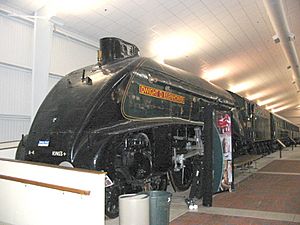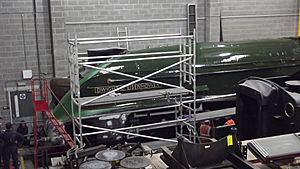LNER Class A4 4496 Dwight D Eisenhower facts for kids
Quick facts for kids Dwight D Eisenhower |
|
| Power type | Steam |
|---|---|
| Builder | Doncaster Works |
| Serial number | 1861 |
| Build date | 4 September 1937 |
| Configuration | 4-6-2 |
| UIC classification | 2′C1 h3 |
| Gauge | 4 ft 8 1⁄2 in (1,435 mm) standard gauge |
| Leading wheel diameter | 3 ft 2 in (0.965 m) |
| Driver diameter | 6 ft 8 in (2.032 m) |
| Trailing wheel diameter | 3 ft 8 in (1.118 m) |
| Boiler pressure | 250 psi (1.72 MPa) |
| Cylinders | Three |
| Cylinder size | 18.5 in × 26 in (470 mm × 660 mm) |
| Tractive effort | 35,455 lbf (157.7 kN) |
| Locomotive brakes | Steam |
| Train brakes | Vacuum |
| Number in class | 19 of 35 |
| Official name | Golden Shuttle, Dwight D Eisenhower |
| Withdrawn | 20 July 1963 |
| Current owner | National Railroad Museum |
| Disposition | Static display at the National Railroad Museum, Ashwaubenon, Green Bay, Wisconsin |
60008 Dwight D Eisenhower is a famous steam locomotive. It belongs to the LNER Class A4 of trains. This locomotive is named after Dwight D. Eisenhower, who was a very important United States General during World War II. He later became the President of the United States.
This amazing train was built in 1937 for the London & North Eastern Railway (LNER) in Britain. It was first called Golden Shuttle and had the number 4496. After World War II, it was renamed Dwight D. Eisenhower to honor the general. Its number also changed to 8 in 1946. Later, in 1948, when British railways became nationalized (owned by the government), its number changed again to 60008.
The locomotive stopped working in 1963. It was then moved to the National Railroad Museum in Green Bay, USA, where you can see it today. In 2012, it traveled back to England for a special event. All the surviving A4 locomotives were brought together at the National Railway Museum in York. After this reunion, Dwight D. Eisenhower returned to Green Bay in 2014.
Contents
Train Colors: A History of Liveries
Like other A4 class locomotives, Dwight D. Eisenhower wore many different colors during its time. These colors are called "liveries."
Original Look: Golden Shuttle's Blue
When it first started running on September 4, 1937, locomotive 4496 was named Golden Shuttle. It was painted in a special LNER garter blue color. It also had shiny stainless steel details on its sides and tender. The numbers and "LNER" letters were also made of stainless steel. This fancy blue color was used on other A4 trains named after countries. It helped them match the special passenger cars they pulled.
Wartime Black and Post-War Blue
During World War II, the train's color changed to wartime black on January 30, 1942. This was a common change for trains during the war. The "LNER" on the tender was later shortened to just "NE" in March 1943.
After the war, on September 25, 1945, the LNER garter blue color was put back. This is when the name Dwight D. Eisenhower was added, though it was kept covered until February 1946.
British Railways Colors
When British Railways took over in 1948, the train's colors changed again. On June 14, 1950, it was painted in a dark blue with black and white stripes. Its final color was Brunswick green, applied on November 9, 1951. This green was a common color for British Railways trains.
Around 1958, the nameplate of Dwight D. Eisenhower had an unusual red background. Also, when the train was based at Grantham, the name of that depot was stenciled on its buffer beam.
How the Locomotive Worked: Technical Details
When Golden Shuttle was first built, it had a single chimney and side valances. These valances were covers over the wheels. They were removed on January 30, 1942, to make it easier to maintain the train.
Later, on August 20, 1958, the locomotive received a double chimney and a special Kylchap double blastpipe. These changes helped the train perform even better. A speed indicator was also added on June 30, 1960.
Dwight D. Eisenhower had several different boilers and two different tenders during its working life. These parts were replaced over time to keep the train running well.
The Train's Journey: Career Highlights
Locomotive 4496 was originally going to be named Sparrow Hawk, but it became Golden Shuttle instead. The name Sparrow Hawk was later used for another train, 4463.
On September 25, 1945, after some work, locomotive 4496 was ready. The next day, it was at Marylebone station for the LNER directors to see. The nameplates were covered because they hoped General Eisenhower himself would come for an official unveiling, but this couldn't be arranged.
Where it was Based
Golden Shuttle was first based at Doncaster for only nine days in September 1937. Then it moved to Kings Cross Top Shed until December 1939, when it went to Grantham.
In June 1950, Dwight D. Eisenhower moved back to Top Shed. It returned to Grantham in April 1957, then back to Top Shed in September 1957. Its last home was the New England shed in Peterborough from June 1963.
End of Service
On October 4, 1962, Dwight D. Eisenhower pulled a special train from Stratford station in East London to York. The staff at Kings Cross Top Shed had specially cleaned it for this trip.
The locomotive was officially taken out of service on July 20, 1963. By this time, newer diesel electric locomotives were taking over the main train routes. So, many A4 steam trains were retired. Dwight D. Eisenhower was given to the United States of America and sent to Doncaster Works for restoration.
Preserving a Legend: Its Journey to the Museum
Dwight D. Eisenhower was chosen for the National Railroad Museum in Ashwaubenon, USA. It was cleaned up and made to look good at Doncaster Works on July 19, 1963. The next spring, it was shipped across the ocean, arriving in New York Harbor on May 11, 1964. It then traveled by train to the museum, arriving later that month.
In October 1990, the locomotive was moved to Abilene, Kansas, for celebrations of Eisenhower's 100th birthday. This move was done very slowly. The train and two special cars used a British braking system, which was different from American trains.
Today, the locomotive is displayed with two British passenger carriages. These cars were once part of Eisenhower's special "Command Train." They have been restored to look just as they did when he used them.
A Trip Back Home: The Great Gathering
For a long time, people wanted to bring the locomotive back to the UK. In 2012, the National Railway Museum announced exciting plans! They would bring Dwight D. Eisenhower and another A4 locomotive, 60010 (which was in Canada), back to England. This was to celebrate the 75th anniversary of the A4 class setting a world speed record of 126 miles per hour.
Both 60008 and 60010 were loaned to the National Railway Museum for two years. They returned to North America in early 2014. While in York, 60008 was carefully cleaned and repainted. It received a new coat of its correct British Railways Brunswick Green paint. The background on its nameplates was also changed from red to black.
In August 2012, 60008 left Green Bay and traveled to Halifax, Nova Scotia, in Canada. There, it met 60010, which arrived by train in September. On October 3, 2012, both locomotives arrived back in the UK at the Port of Liverpool. The next day, 60008 began its journey to the National Railway Museum Shildon, arriving that evening. It then moved to York for its restoration.
The restoration of 60008 was finished in February 2013. It was then displayed in the Great Hall at the National Railway Museum in York, right next to its sister engine, 4468 Mallard.
The Great Gathering and Goodbye
60008 and Mallard later joined the other four A4s for a two-week event in York called 'The Great Gathering'. This event started on July 3, 2013, exactly 75 years after Mallard set the world speed record. Both 60008 and 60010 also appeared at Barrow Hill Engine Shed with Bittern (60019) in February 2014.
The journey of these two North American A4s back to the UK was even featured on a TV show called Monster Moves in August 2013.
The last event where all six A4 sisters were together was 'The Great Goodbye'. It took place from February 15 to 23, 2014, at the National Railway Museum's Locomotion annex at Shildon. During this time, the National Railroad Museum was offered a lot of money for the engine to stay in the UK, but they said no.
The engine remained on display until mid-April 2014. Then, 60008 and 60010 were covered up and sent to the Port of Liverpool. They were loaded onto a ship for their voyage back to Halifax. The engines were unloaded in Halifax on May 11 and put on flat cars to travel by rail to their museums.
60008 arrived back at the National Railroad Museum in Green Bay on June 6, 2014. By June 23, it was back in its display building. The museum officially showed off the engine as part of a new World War II exhibit on August 2, 2014.
Collecting Models: Dwight D. Eisenhower in Miniature
If you're a fan of model trains, you might be interested to know that models of 60008 Dwight D. Eisenhower have been made!
In 2012, Bachmann released a model to celebrate the locomotive's return to the UK. In 2013, Hornby also released a special limited edition model of 60008, along with the other five surviving A4s. In 2015, Hornby released another model of it, showing its original garter blue color and its first name, Golden Shuttle.




